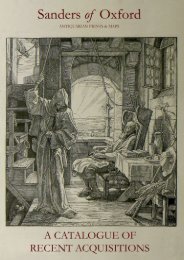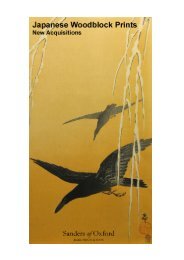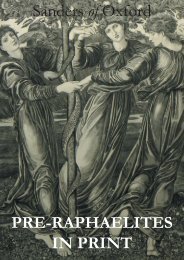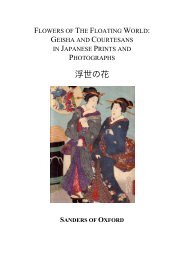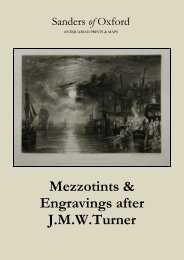«Heading» - International League of Antiquarian Booksellers
«Heading» - International League of Antiquarian Booksellers
«Heading» - International League of Antiquarian Booksellers
You also want an ePaper? Increase the reach of your titles
YUMPU automatically turns print PDFs into web optimized ePapers that Google loves.
Condition: Trimmed to plate mark and laid to album<br />
paper.<br />
[27653]<br />
£250<br />
45. The Queen and the Prince Consort at Windsor<br />
Castle _ 1843.<br />
Mezzotint<br />
Richard Josey after Edwin Landseer<br />
c.1889<br />
Image 119 x 173 mm, Plate 147 x 184 mm, Sheet 175 x<br />
251 mm<br />
Unmounted<br />
Gainsborough and Frank Holl. The National Gallery has<br />
twenty portraits engraved by Josey in its collection.<br />
Josey married Elizabeth Croxon in 1864. The Joseys<br />
had fourteen children including the well-known mosaic<br />
artist Maurice Josey,<br />
O’Donoghue & Hake (Vol. V, Groups) 38, Printsellers’<br />
Association Index 209<br />
Ex. Col.: Hon. Christopher Lennox-Boyd<br />
[27765]<br />
£65<br />
British Political<br />
Based on Sir Edwin Landseer’s Windsor Castle in<br />
Modern Times, first discussed two months after the<br />
royal couple’s marriage on 13 April 1840; and was<br />
planned as a happy sequel to Queen Victoria riding out<br />
which was exhibited in the same year. It was finally<br />
hung in Windsor Castle in 1845 and Landseer was paid<br />
800 guineas for the piece. Prince Albert is depicted as a<br />
Park Ranger who has spent the day shooting and returns<br />
laden with booty - kingfisher, jay, mallard, woodcock,<br />
pheasant and ptarmigan - which he proudly spreads out<br />
upon the drawing room carpet. He sits in outdoor<br />
clothing, with muddy boots, bag and powder pouch,<br />
patting his favourite dog, Eos, while Dandy Dinmont,<br />
Islay and Cairnach fuss around. The Queen welcomes<br />
her husband home by presenting him with a nosegay;<br />
their daughter plays with a dead kingfisher, a ‘Halcyon’,<br />
symbol <strong>of</strong> peace. The scene is set in the White Drawing<br />
Room at Windsor, decorated with the Morel and Seddon<br />
furniture commissioned by George IV, and with a view<br />
<strong>of</strong> the East Terrace.<br />
Richard Josey (1840-1906) was a prominent mezzotint<br />
engraver who <strong>of</strong>ten combined the process with other<br />
techniques to produce so-called 'mixed manner' prints.<br />
Born in Reading, Josey was first apprenticed at the age<br />
<strong>of</strong> thirteen to Thomas W. Knight, and later worked in<br />
the studio <strong>of</strong> the Chevalier Ballin. His influence can be<br />
seen in Josey’s work in stipple and line. His first<br />
commission was reportedly from the print publishers<br />
Henry Graves and Co., for whom he worked for many<br />
years afterwards. Between 1876 and 1887 he exhibited<br />
nineteen works at the Royal Academy. Josey engraved a<br />
large number <strong>of</strong> famous portraits after artists including<br />
James McNeill Whistler, John Everett Millais,<br />
46. Melbourne<br />
Lithograph<br />
Charles Hullmandel after Benjamin Robert Haydon<br />
Published by Tho’s McLean, 26, Haymarket, London,<br />
June 25th, 1833<br />
Image 390 x 363 mm, Sheet 514 x 369 mm<br />
unmounted<br />
Study for the picture <strong>of</strong> the Reform Banquet.<br />
William Lamb, 2nd Viscount Melbourne (1779-1848)<br />
was Prime Minister From 1830-34. Melbourne was<br />
Home Secretary under Lord Grey, although he was a<br />
firm believer in aristocratic government. After Grey's<br />
resignation he was appointed Prime Minister, a position<br />
he held twice between 1834 and 1841.<br />
Benjamin Robert Haydon (1786 - 1846) was a history<br />
painter and friend <strong>of</strong> John Keats and William<br />
Wordsworth. Although Haydon aspired to achieve<br />
greatnes as a historical painter he was best known for<br />
his autobiographical writings. The Life <strong>of</strong> Benjamin<br />
Robert Haydon, Historical Painter, from His<br />
Autobiography and Journals (1853) was published after<br />
his death upon request <strong>of</strong> his wife and has since been<br />
reissued in modified forms several times.




